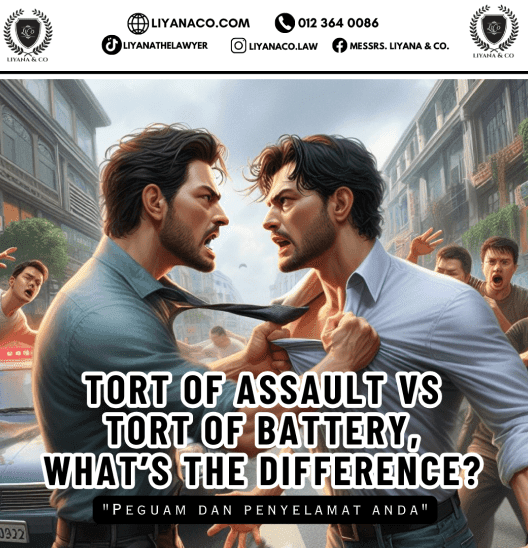
The torts of assault and battery are often discussed together because they both involve harmful or offensive conduct, but they are distinct legal concepts:
Assault:
Assault involves the threat of imminent harm or offensive contact. It doesn’t necessarily require physical contact to occur. Instead, it’s about creating a reasonable apprehension or fear of harm in the victim.
For example, if someone raises their fist and threatens to punch another person without actually touching them, it could be considered assault.
Battery:
Battery, on the other hand, involves actual harmful or offensive physical contact with another person. It doesn’t require the victim to have been injured; rather, any unauthorized physical contact can constitute battery.
For instance, if someone intentionally punches another person and makes physical contact, it could be considered battery.
In summary, assault is about creating fear or apprehension of harm, while battery involves actual harmful or offensive physical contact. Both can lead to legal claims for compensation for the harm caused.
Can the tort of assault be committed over a phone call?
Yes, the tort of assault can occur through phone or any other form of communication if the communication is such that it creates a reasonable apprehension of imminent harmful or offensive contact. This could include threats made over the phone that make the recipient fear for their safety or well-being.
For example, if someone calls another person and threatens to physically harm them in a credible and immediate way, such as stating they will come to their house to cause harm, this could constitute assault even though no physical contact has occurred. The key is whether the communication creates a reasonable fear of imminent harm or offensive contact in the mind of the recipient.
Tort of Battery: does not necessarily require physical contact
Yes, the tort of battery can occur without direct physical contact if there is an intentional and harmful or offensive touching of another person’s body or something closely connected to their body. This can include situations where an object is thrown or projected at someone in a way that makes contact and causes harm.
For example, if someone throws a rock at another person and it makes contact, causing injury or harm, this could constitute battery even though there was no direct physical contact between the individuals. The key elements are the intentional act and the harmful or offensive contact with the person or something closely connected to them. If these elements are present, a claim for battery may be justified.
CASE: AHMAD FARID bin ALI v rohaya binTI malik (NOT REAL NAME) [2021] 9 MLJ 82
CASE:
The case involved an appeal regarding the tort of battery. The appellant husband had committed multiple acts of physical assault against the respondent wife, occurring both at home and in public spaces. These assaults were referred to as the “first battery,” “second battery,” and “third battery.”
In the “first battery,” which occurred at home in front of their children, maid, and chauffeur, the appellant physically assaulted the respondent. Subsequently, the appellant scolded and hit the respondent at a reception counter in Permodalan Nasional Bhd (“PNB”) in the “second battery.” Later, at the car park, the appellant assaulted the respondent again in the “third battery.”
Legal proceedings ensued, with the respondent filing an action in the sessions court seeking damages for the three batteries. The appellant counterclaimed for the return of a sum of money and aggravated damages.
The sessions court ruled in favor of the respondent, awarding damages and dismissing the counterclaim. The appellant appealed this decision.
Key issues addressed in the appeal included:
- Whether a specific section of the Criminal Procedure Code barred the respondent from filing the original action.
- Jurisdictional questions regarding whether the civil court or the Syariah Court could hear claims for the tort of battery and breach of trust.
- The admissibility of certain evidence, including a CCTV recording.
- Whether the lower court had made factual errors in assessing the incidents.
- Whether the damages awarded were appropriate.
The appellate court dismissed the appellant’s appeal against the decision regarding the original action but allowed the appeal concerning the counterclaim, striking it out with no order as to costs. The court affirmed the damages awarded by the sessions court, finding them justified based on the evidence presented and the gravity of the appellant’s conduct.
Elements to establish tort of assault
To establish the tort of assault, these 3 elements must be met:
- Defendant’s Mental State
- Effect on Plaintiff
- Capability to perform such attacks
Elements of battery
To prove battery has occurred, these 3 elements need to be satisfied:
(a)the defendant has committed an act (‘act’) which directly causes physical contact with the plaintiff;
(b)the act is done without the plaintiff’s consent; and
(c)the act is done intentionally or negligently by the defendant.
Do you need answers and solutions in a legal action? Get legal advice from our lawyers at Liyana & Co.
Our lawyers have 10 years of experience in solving complex legal problems.
“Your Legal Savior”
📞📱 Let’s set an appointment and contact us at: